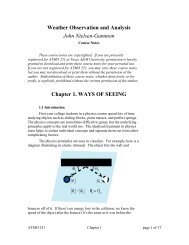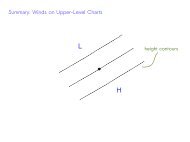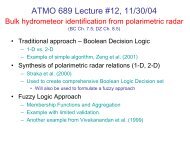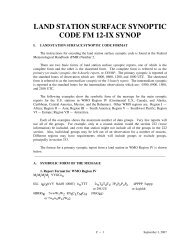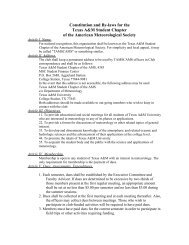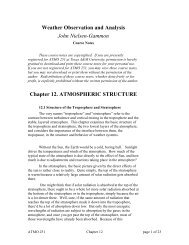Chapter 13: Fronts and Frontogenesis - Texas A&M University
Chapter 13: Fronts and Frontogenesis - Texas A&M University
Chapter 13: Fronts and Frontogenesis - Texas A&M University
Create successful ePaper yourself
Turn your PDF publications into a flip-book with our unique Google optimized e-Paper software.
though they extend up above the planetary boundary layer, because the<br />
strongest wind variations <strong>and</strong> temperature gradients tend to be at the<br />
surface. Surface fronts typically weaken with height, <strong>and</strong> while it is<br />
possible for surface fronts to connect with upper-level fronts <strong>and</strong> thereby<br />
extend through the entire depth of the troposphere, most surface fronts<br />
peter out near the 600 mb to 800 mb level.<br />
Surface fronts have specific structural characteristics that are<br />
important for underst<strong>and</strong>ing the weather associated with them. The<br />
following discussion applies specifically to variations of weather elements<br />
observed at ground level.<br />
First, the zone of strong temperature gradient is generally much<br />
wider than the zone over which the wind shift occurs. In other words,<br />
while the temperature gradient zone is rather narrow, the wind shift is very<br />
narrow.<br />
Second, the wind shift, which is collocated with (or at worst within<br />
a few miles of) the pressure trough, is at the warm edge of the temperature<br />
gradient.<br />
Third, if there’s a dewpoint change across the front, the dewpoint<br />
change tends to be even more rapid than the temperature change.<br />
Fourth, while there’s often cloudiness <strong>and</strong> precipitation associated<br />
with cold fronts, they can occur on either side of the front, well ahead of<br />
the front, or not at all. Warm fronts are a bit better behaved: if there’s to<br />
be rain or snow associated with a warm front, it will usually be found<br />
ahead of it, on the cold side. The weather associated with stationary fronts<br />
<strong>and</strong> occluded fronts is similar to that associated with warm fronts.<br />
ATMO 251 <strong>Chapter</strong> <strong>13</strong> page 4 of 22



